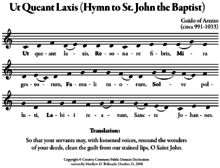Four works are securely attributed to Guido:[23] the Micrologus, the Prologus in antiphonarium, the Regulae rhythmicae and the Epistola ad Michaelem.[7][n 2]
The Epistola ad Michaelem is the only one not a formal musical treatise; it was written directly after Guido's trip to Rome,[20] perhaps in 1028,[7] but no later than 1033.[20] All three musical treatise were written before the Epistola ad Michaelem, as Guido mentions each of them in it.[20] More specifically, the Micrologus can be dated to after 1026, as in the preliminary dedicatory letter to Tebald, Guido congratulates him for his 1026 plans for the new St Donatus church.[20] Though the Prologus in antiphonarium was begun in Pomposa (1013–1025), it seems to have not been completed until 1030.[20]
Solmization
Guido developed new techniques for teaching, such as staff notation and the use of the "ut–re–mi–fa–sol–la" (do–re–mi–fa–so–la) mnemonic (solmization). The syllables ut-re-mi-fa-sol-la (do-re-mi-fa-sol-la-si) are taken from the initial syllables of each of the first major philosophical concepts of the Middle Ages - "dоminus", "rerum", "miraculum", "familias", "solis", "lacteal via", "siderae", or, according to Catholic sources, the six half-lines of the first stanza of the hymn Ut queant laxis, the notes of which are successively raised by one step, and the text of which is attributed to the Italian monk and scholar Paulus Deacon (although the musical line either shares a common ancestor with the earlier setting of Horace's Ode to Phyllis (Odes 4.11) recorded in Montpellier manuscript H425, or may have been taken from there)[24] Giovanni Battista Doni is known for having changed the name of note "Ut" (C), renaming it "Do" (in the "Do Re Mi ..." sequence known as solfège).[25] A seventh note, "Si" (from the initials for "Sancte Iohannes," Latin for Saint John the Baptist) was added shortly after to complete the diatonic scale.[26] In anglophone countries, "Si" was changed to "Ti" by Sarah Glover in the nineteenth century so that every syllable might begin with a different letter (this also freed up Si for later use as Sol-sharp). "Ti" is used in tonic sol-fa and in the song "Do-Re-Mi".
You received this message because you are subscribed to the Google Groups "1TopReadys1" group.
To unsubscribe from this group and stop receiving emails from it, send an email to 1topreadys1+unsubscribe@googlegroups.com.
To view this discussion on the web visit https://groups.google.com/d/msgid/1topreadys1/CALML-R2SW5U4en%2Bb4cnhRCYXW%2BAYZq5OhG978iV%3DohZ95F_xZg%40mail.gmail.com.

No comments:
Post a Comment